Study identifies Bill and Melinda Gates and Rockefeller foundations among rich donors that are close to government and may be skewing priorities
This article is more than 8 years old

The German chancellor Angela Merkel and Bill Gates at talks in Berlin in 2014. A new study reveals the access billionaire philanthropists have to political elites.
Supported by

John Vidal Fri 15 Jan 2016
Ultra-rich philanthropists and their foundations have increasing influence on decision-making and are setting the global health and agriculture agenda in developing countries, according to a major study (pdf).
Using their immense wealth and influence with political and scientific elites, organisations like the Bill and Melinda Gates Foundation, the Rockefeller Foundation and others are promoting solutions to global problems that may undermine the UN and other international organisations, says the report by the independent Global Policy Forum, which monitors the work of UN bodies and global policymaking.
With assets of more than $360bn (£250bn), the world’s 27 largest foundations give roughly $15bn annually to charitable causes. Nineteen of the 27 are American and many are now looking to extend their influence to poorer countries, say the report’s authors.
Foundation spending on global development has increased from $3bn a year in the early 2000s to $10bn today. By far the largest donor, say the authors, is the Bill and Melinda Gates Foundation, which in 2012 gave $2.6bn. This compares with $1.2bn from the next nine largest US trusts.
In addition, 137 billionaires from 14 countries have now pledged to give to philanthropiccauses. They include the former mayor of New York City Michael Bloomberg, the US filmmaker George Lucas and the Facebook founder Mark Zuckerberg.
“If these and more ultra-rich fulfil their pledges, many more billions of dollars will be made available for charitable purposes,” says the report, which was financed by Misereor and Brot für die Welt, two German church groups that work largely in Africa.
The study claims many foundations enable rich countries and their corporations to achieve their own ends in developing countries, from setting up public-private partnerships with pharmaceutical companies to promoting certain sorts of corporate farming and the use of biotechnology for health and agriculture.
The authors ask whether the foundations are now sidelining governments and shifting influencing the work of international bodies. “Through the sheer size of their grant-making, personal networking and active advocacy, large global foundations have played an increasingly active role in shaping the agenda-setting and funding priorities of international organisations and governments.
“So far there has been a fairly willing belief among governments and international organisations in the positive role of philanthropy.” But, say the authors, a thorough assessment is now necessary because the wealthy may be skewing the priorities of the poor.
“They should analyse the intended and unintended risks and side-effects of their activities, particularly the fragmentation of global governance, the weakening of representative democracy … the prevailing practice of applying business logic to the provision of public goods.”
The authors say foundations have used their influence well to get governments to tackle poverty. “Their advocacy for global causes puts pressure on governments, and sometimes the private sector, to become more actively engaged.”
But this raises concerns about how they and their corporate partners may be taking over from the UN and weakening public health systems in developing countries. “As the UN accelerates its engagement with the business and corporate sector, as well as philanthropic foundations, it lacks the rules and tools needed to ensure it does not lose sight of its original mission.
“Through their multiple channels of influence, the Rockefeller and Gates foundations have been very successful in promoting their market-based and bio-medical approaches towards global health challenges in the research and health policy community – and beyond.”
Their strategy includes placing people in international organisations, and gaining privileged access to scientific, business and political elites.
For example, when Bill Gates visited Berlin to campaign for the Gavi Alliance (the vaccine alliance of governments, NGOs and companies set up with Gates and Rockefeller money), he met the German chancellor and the foreign, finance, development and health ministers.
“The Gates foundation has successfully positioned itself in the centre of a … community that is promoting market-based, techno-fix solutions to the complex global problems of hunger and malnutrition,” say the authors.
Leonora Diller, spokeswoman for the Gates foundation said: “The problems affecting the world’s poorest are complex and we believe that solving them requires the close collaboration of governments, NGOs, academic institutions and for-profit businesses. Governments and international organisations provide the leadership and resources.
We believe that the role of philanthropy is to take risks where others can’t or won’t
Gates Foundation
“The private sector has access to life-saving innovations and we believe that the role of philanthropy is to take risks where others can’t or won’t. Our investments are substantial, but just one piece of the puzzle.”
According to the report, the Gates foundation is now the second largest donor to the World Health Organisation after the US, as well as one of the world’s largest single investors in biotechnology for farming and pharmaceuticals. But while the billions of dollars for research is welcomed in rich countries, its massive power to shift the agenda is questioned elsewhere.
“The mushrooming of global partnerships, particularly in the health sector, has led to isolated and often poorly coordinated solutions. These initiatives have not only contributed to the institutional weakening of the UN ands its specialised agencies but have undermined national development strategies,” it says.
“Médecins Sans Frontières (MSF) states that, while Gavi has helped to lower prices of new and underused vaccines for eligible countries, the cost to fully immunise a child was 68 times more expensive in 2014 than it was in 2001.” The report also questions why the Gates foundation invests heavily in companies like Monsanto and Bayer. “In addition to its grant-making activities, the Gates foundation has recently stepped up its support for the biotechnological industry directly.” In February, it took a $52m equity stake in CureVac, a German bio-pharmaceutical company.
“There is a revolving door between the Gates foundation and pharmaceutical corporations. Many of the foundation’s staff had held positions at pharmaceutical companies,” the report adds.

The Rockefeller Foundation president Judith Rodin (L) is seen with USAid’s Rajiv Shah at a food security forum in 2014.
The study says: “Both Gates and the Rockefeller Foundation regard technological innovation and close cooperation with the food and agricultural industries as key to overcoming hunger … In 2006 they together launched the Alliance for a Green Revolution in Africa (Agra), based on the premise that hunger in Africa is mainly the result of a lack of technology and functioning markets. [This] changed the farming agenda in Africa,” say the authors.
Since then Gates has given more than $3bn to support 660 agricultural projects as well as several hundred million dollars for nutrition. “The vast majority of grants focus on Africa. However, more than 80% of the $669m to NGOs went to organisations based in the US and Europe, with only 4% going to Africa-based NGOs.”The report claims Agra has been intervening directly in the formulation of African governments’ agricultural policies on issues like seeds and land. “Because of its focus on bio-technological farming methods, it has increasingly promoted GM seeds. Critics claim that under the guise of eliminating hunger in Africa, it is a tool to open African markets to US agri-buiness,” says the report.
https://www.theguardian.com/media/2016/jan/15/bill-gates-to-appear-on-bbcs-desert-island-discs
Achieng’ Otieno, a spokeswoman for the Rockefeller’s Africa office, said: “The agricultural research that the Rockefeller Foundation funded through the green revolution saved millions of lives. Today our focus is on making better use of the resources that go into food production, and in particular reducing both post-harvest losses and retail- and consumer-level food waste.
“These are the biggest food security issues of our day, and, yes, we want to influence decisions so that more food ends up on tables and in mouths and far less of it in landfills, particularly as we want to see this done in a way that benefits smallholder farmers.”
Diller said: “It’s important to point out that in all of our grant-making we are guided by the evidence and by the deep research and expertise of our partners and grantees … Our open access policy reflect[s] our commitment to the open exchange of information across our work. We continue to try to do all we can to be transparent and accountable to our investments and our decision-making.”
The world’s largest philanthropic foundations

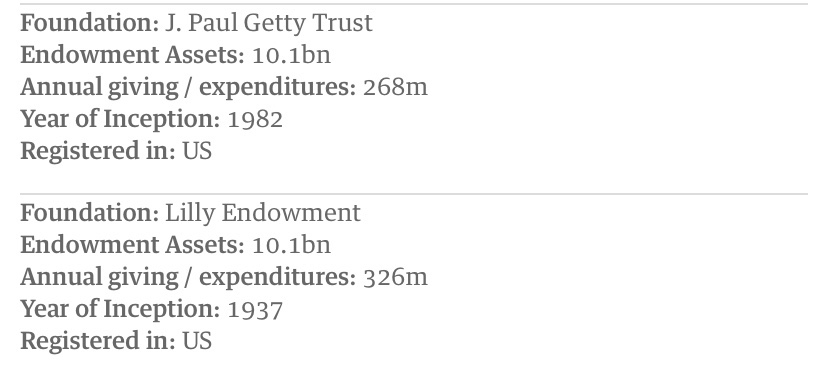
Rock é Feller of „the Science“
The Rockefeller Foundation is an American private foundation and philanthropic medical research and arts funding organization based at 420 Fifth Avenue, New York City.[3] The second-oldest major philanthropic institution in America, after the Carnegie Corporation, the foundation was ranked as the 39th largest U.S. foundation by total giving as of 2015.[4] By the end of 2016, assets were tallied at $4.1 billion (unchanged from 2015), with annual grants of $173 million.[5]According to the OECD, the foundation provided US$283.9 million for development in 2021.[6] The foundation has given more than $14 billion in current dollars.[7]The Rockefeller Foundation Founded May 14, 1913; 110 years ago Founders John D. Rockefeller
John D. Rockefeller & Jr. Frederick Taylor Gates
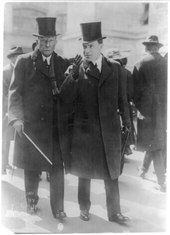
The foundation has had an international reach since the 1930s and major influence on global non-governmental organizations. The World Health Organization is modeled on the International Health Division of the foundation, which sent doctors abroad to study and treat human subjects. The National Science Foundation and National Institute of Health are also modeled on the work funded by Rockefeller.[7] It has also been a supporter of and influence on the United Nations.
In 2020 the foundation pledged that it would divest from fossil fuel, notable since the endowment was largely funded by Standard Oil.[8]The foundation also has a controversial past, including support of eugenics in the 1930s, as well as several scandals arising from their international field work. In 2021 the foundation’s president committed to reckoning with their history, and to centering equity and inclusion.
John D. Rockefeller Sr. first conceived the idea of the foundation in 1901. In 1906, Rockefeller’s business and philanthropic advisor, Frederick Taylor Gates, encouraged him toward „permanent corporate philanthropies for the good of Mankind“ so that his heirs should not „dissipate their inheritances or become intoxicated with power.“[9]In 1909 Rockefeller signed over 73,000 Standard Oil shares worth $50 million, to his son, Gates and Harold Fowler McCormick as the third inaugural trustee, in the first installment of a projected $100 million endowment.[9]
The nascent foundation applied for a federal charter in the US Senate in 1910, with at one stage Junior even secretly meeting with President William Howard Taft, through the aegis of Senator Nelson Aldrich, to hammer out concessions.[citation needed] However, because of the ongoing (1911) antitrust suit against Standard Oil at the time, along with deep suspicion in some quarters of undue Rockefeller influence on the spending of the endowment, the result was that Senior and Gates withdrew the bill from Congress in order to seek a state charter from New York.[9]

On May 14, 1913, New York Governor William Sulzer approved a charter for the foundation with Junior becoming the first president. With its large-scale endowment, a large part of Senior’s fortune was insulated from inheritance taxes.[9] The first secretary of the foundation was Jerome Davis Greene, the former secretary of Harvard University, who wrote a „memorandum on principles and policies“ for an early meeting of the trustees that established a rough framework for the foundation’s work.[citation needed] It was initially located within the family office at Standard Oil’s headquarters at 26 Broadway, later (in 1933) shifting to the GE Building (then RCA), along with the newly named family office, Room 5600, at Rockefeller Center; later it moved to the Time-Life Building in the center, before shifting to its current Fifth Avenue address.
In 1914, the trustees set up a new Department of Industrial Relations, inviting William Lyon Mackenzie King to head it. He became a close and key advisor to Junior through the Ludlow Massacre, turning around his attitude to unions; however the foundation’s involvement in IR was criticized for advancing the family’s business interests.[10] The foundation henceforth confined itself to funding responsible organizations involved in this and other controversial fields, which were beyond the control of the foundation itself.[11]
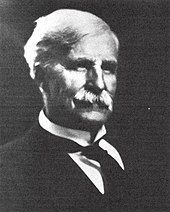
Junior became the foundation chairman in 1917. Through the Laura Spelman Rockefeller Memorial(LSRM), established by Senior in 1918 and named after his wife, the Rockefeller fortune was for the first time directed to supporting research by social scientists. During its first few years of work, the LSRM awarded funds primarily to social workers, with its funding decisions guided primarily by Junior. In 1922, Beardsley Ruml was hired to direct the LSRM, and he most decisively shifted the focus of Rockefeller philanthropy into the social sciences, stimulating the founding of university research centers, and creating the Social Science Research Council. In January 1929, LSRM funds were folded into the Rockefeller Foundation, in a major reorganization.[12]
The Rockefeller family helped lead the foundation in its early years, but later limited itself to one or two representatives, to maintain the foundation’s independence and avoid charges of undue family influence. These representatives have included the former president John D. Rockefeller III, and then his son John D. Rockefeller, IV, who gave up the trusteeship in 1981. In 1989, David Rockefeller’s daughter, Peggy Dulany, was appointed to the board for a five-year term. In October 2006, David Rockefeller Jr. joined the board of trustees, re-establishing the direct family link and becoming the sixth family member to serve on the board.[citation needed]

C. Douglas Dillon, the United States Secretary of the Treasury under both Presidents John F. Kennedy and Lyndon B. Johnson, served as chairman of the foundation.[13]
Stock in the family’s oil companies had been a major part of the foundation’s assets, beginning with Standard Oil and later with its corporate descendants, including ExxonMobil.[14][15][16] In December 2020, the foundation pledged to dump their fossil fuel holdings. With a $5 billion endowment, the Rockefeller Foundation was „the largest US foundation to embrace the rapidly growing divestment movement.“ CNN writer Matt Egan noted, „This divestment is especially symbolic because the Rockefeller Foundation was founded by oil money.“[8]

Public health
Public health, health aid, and medical research are the most prominent areas of work of the foundation. On December 5, 1913, the Board made its first grant of $100,000 to the American Red Cross to purchase property for its headquarters in Washington, D.C.[17]
The foundation established the Johns Hopkins School of Public Health and Harvard School of Public Health, two of the first such institutions in the United States,[18][19] and established the School of Hygiene at the University of Toronto in 1927, and the London School of Hygiene and Tropical Medicine in the United Kingdom.[20] they spent more than $25 million in developing other public health schools in the US and in 21 foreign countries. In 1913, it also began a 20-year support program of the Bureau of Social Hygiene, whose mission was research and education on birth control, maternal health and sex education. In 1914, the foundation set up the China Medical Board, which established the first public health university in China, the Peking Union Medical College, in 1921; this was subsequently nationalized when the Communists took over the country in 1949. In the same year it began a program of international fellowships to train scholars at many of the world’s universities at the post-doctoral level. The Foundation also maintained a close relationship with Rockefeller University (also known as the Rockefeller Institute for Medical Research) with many faculty holding overlapping positions between the institutions.[21]

The Sanitary Commission for the Eradication of Hookworm Disease was a Rockefeller-funded campaign from 1909 to 1914 to study and treat hookworm disease in 11 Southern states.[22][23][24] Hookworm was known as the „germ of laziness„. In 1913, the foundation expanded its work with the Sanitary Commission abroad and set up the International Health Division [25] (also known as International Health Board), which began the foundation’s first international public health activities. The International Health Division conducted campaigns in public health and sanitation against malaria, yellow fever, and hookworm in areas throughout Europe, Latin America and the Caribbean including Italy, France, Venezuela, Mexico,[26][27] and Puerto Rico,[28]totaling fifty-two countries on six continents and twenty-nine islands.[29] The first director was Wickliffe Rose, followed by F.F. Russell in 1923, Wilbur Sawyer in 1935, and George Strode in 1944. A number of notable physicians and field scientists worked on the international campaigns, including Lewis Hackett, Hideyo Noguchi, Juan Guiteras, George C. Payne, Livingston Farrand, Cornelius P. Rhoads, and William Bosworth Castle.

The World Health Organization, seen as a successor to the IHD, was formed in 1948, and the IHD was subsumed by the larger Rockefeller Foundation in 1951, discontinuing its overseas work.[25]
While the Rockefeller doctors working in tropical locales such as Mexico emphasized scientific neutrality, they had political and economic aims to promote the value of public health to improve American relations with the host country. Although they claimed the banner of public health and humanitarian medicine, they often engaged with politics and business interests.[26] Rhoads was involved in a racism whitewashing scandal in the 1930s during which he joked about injecting cancer cells into Puerto Rican patients, inspiring Puerto Rican nationalist and anti-colonialist leader Pedro Albizu Campos.[30] Noguchi was also involved in an unethical human experimentationscandal.[28] Susan Lederer, Elizabeth Fee, and Jay Katz are among the modern scholars who have researched this period. Researchers with the foundation including Noguchi developed the vaccine to prevent yellow fever.[31][32] Rhoads later became a significant cancer researcher and director of Memorial Sloan-Kettering, though his eponymous award for oncological excellence was renamed after the scandal reemerged.[33]

During the late-1920s, the Rockefeller Foundation created the Medical Sciences Division, which emerged from the former Division of Medical Education. The division was led by Richard M. Pearce until his death in 1930, to which Alan Gregg succeeded him until 1945.[34] During this period, the Division of Medical Sciences made contributions to research across several fields of psychiatry.[35] In 1935 the foundation granted $100000 to the Institute for Psychoanalysis in Chicago.[36] This grant was renewed in 1938, with payments extending into the early-1940s.[37] This division funded women’s contraception and the human reproductive system in general, but also was involved in funding controversial eugenics research. Other funding went into endocrinology departments in American universities, human heredity, mammalian biology, human physiology and anatomy, psychology, and the studies of human sexual behavior by Alfred Kinsey.[38]
In the interwar years, the foundation funded public health, nursing, and social work in Eastern and Central Europe.[39][40]
In 1950, the foundation expanded their international program of virus research, establishing field laboratories in Poona, India, Trinidad, Belém, Brazil, Johannesburg, South Africa, Cairo, Egypt, Ibadan, Nigeria, and Cali, Colombia, among others.[41] The foundation funded research into the identification of human viruses, techniques for virus identification, and arthropod-borne viruses.[42]
Bristol-Myers Squibb, Johns Hopkins University and the Rockefeller Foundation are currently the subject of a $1 billion lawsuit from Guatemala for „roles in a 1940s U.S. government experiment that infected hundreds of Guatemalans with syphilis„.[43] A previous suit against the United States government was dismissed in 2011 for the Guatemala syphilis experiments when a judge determined that the U.S. government could not be held liable for actions committed outside of the U.S.[44]

An experiment was conducted by Vanderbilt University in the 1940s where they gave 800 pregnant women radioactive iron,[45][46] 751 of which were pills,[47] without their consent.[46] In a 1969 article published in the American Journal of Epidemiology, it was estimated that three children had died from the experiment.[47]
John D. Rockefeller Jr. was an outspoken supporter of eugenics.[48] Even as late as 1951, John D. Rockefeller III and John Foster Dulles, who was chairman of the foundation at the time, established the Population Council to advance family planning, birth control, and population control, and goals of the eugenics movement.[49][50][51]
The Rockefeller Foundation, along with the Carnegie Institution, was the primary financier for the Eugenics Record Office, until 1939.[52][53] The foundation also provided grants to Margaret Sanger and Alexis Carrel, who supported birth control, compulsory sterilization and eugenics.[54]Sanger went to Japan in 1922 and influenced the birth control movement there.[55]
By 1926, Rockefeller had donated over $400,000, which would be almost $4 million adjusted for inflation in 2003, to hundreds of German researchers,[56] including Ernst Rüdin[57] and Otmar Freiherr von Verschuer, through funding the Kaiser Wilhelm Institute of Anthropology, Human Heredity, and Eugenics,[58] (also known as the Max Planck Institute for Medical Research[59]) which conducted eugenics experiments in Nazi Germany and influenced the development of Nazi racial scientific ideology. Rockefeller spent almost $3 million between 1925 and 1935, and also funded other German eugenicists, Herman Poll, Alfred Grotjahn, Eugen Fischer, and Hans Nachsteim, continuing even after Hitler’s ascent to power in 1933; Rüdin’s work influenced compulsory sterilisation in Nazi Germany.[60]Josef Mengele worked as an assistant in Verschuer’s lab, though Rockefeller executives did not know of Mengele and stopped funding that specific research before World War II started in 1939.[56]

The Rockefeller Foundation continued funding German eugenics research even after it was clear that it was being used to rationalize discrimination against Jewish people and other groups, after the Nuremberg laws in 1935. In 1936, Rockefeller fulfilled pledges of $655,000 to Kaiser Wilhelm Institute, even though several distinguished Jewish scientists had been dropped from the institute at the time.[61] The Rockefeller Foundation did not alert the world about the racist implications of Nazi ideology, but furthered and funded eugenic research through the 1930s.[62]Even into the 1950s, Rockefeller continued to provide some funding for research borne out of German eugenics.[63]
The foundation also funded the relocation of scholars threatened by the Nazis to America in the 1930s,[64] known as the Refugee Scholar Program and the Emergency Committee in Aid of Displaced Foreign Scholars.[65][66][67] Some of the notable figures relocated or saved, among a total of 303 scholars, were Thomas Mann, Claude Lévi-Strauss and Leó Szilárd.[68] The foundation helped The New School provide a haven for scholars threatened by the Nazis.[69]

After World War II the foundation sent a team to West Germany to investigate how it could become involved in reconstructing the country. They focused on restoring democracy, especially regarding education and scientific research, with the long-term goal of reintegrating Germany into the Western world.[70]
The foundation also supported the early initiatives of Henry Kissinger, such as his directorship of Harvard’s International Seminars (funded as well by the Central Intelligence Agency) and the early foreign policy magazine Confluence, both established by him while he was still a graduate student.[71]
In 2021, Rajiv J. Shah, president of the Rockefeller Foundation, released a statement condemning eugenics and supporting the anti-eugenics movement. He stated that
„[…]we commend the Anti-Eugenics Project for their essential work to understand[…] the harmful legacies of eugenicist ideologies. […] examine the role that philanthropies played in developing and perpetuating eugenics policies and practices. The Rockefeller Foundation is currently reckoning with our own history in relation to eugenics. This requires uncovering the facts and confronting uncomfortable truths, […] The Rockefeller Foundation is putting equity and inclusion at the center of all our work: […] confronting the hateful legacies of the past […] we understand that the work we engage in today does not absolve us of yesterday’s mistakes. […]“ [72]
Clearly and now we left no one behind the vaccine scene!!! Going back to the never again Compulsory medicine and pushing Kidsinto horror experience to Conversion his sexes by the age of 10 and put them on dangerous hormone drugs. Also use them to terrorize free speech and build up the surveillance state…
Development of the United Nations
Although the United States never joined the League of Nations, the Rockefeller Foundation was involved, and by the 1930s the foundations had changed the League from a „Parliament of Nations“ to a modern think tank that used specialized expertise to provide in-depth impartial analysis of international issues.[73][74] After the war, the foundation was involved in the establishment of the United Nations.[75]
Arts and philanthropy

Senate House (University of London) was built on donation from Rockefeller Foundation in 1926 and foundation stone laid by King George V in 1933. It is the headquarters of the University of Londonsince 1937.[citation needed]
In the arts the Rockefeller Foundation has supported the Stratford Shakespeare Festival in Ontario, Canada, and the American Shakespeare Festival in Stratford, Connecticut, Arena Stage in Washington, D.C., Karamu House in Cleveland, and Lincoln Center in New York. The foundation underwrote of Spike Lee’s documentary on New Orleans, When the Levees Broke. The film has been used as the basis for a curriculum on poverty, developed by the Teachers College at Columbia University for their students.[76]
The Cultural Innovation Fund is a pilot grant program that is overseen by Lincoln Center.[77][78]The grants are to be used towards art and cultural opportunities in the underserved areas of Brooklyn and the South Bronx[79] with three overarching goals.
The Rockefeller Foundation supported the art scene in Haiti in 1948[80] and a literacy project with UNESCO.[81]
Rusk was involved with funding the humanities and the social sciences during the Cold Warperiod, including study of the Soviet Union.[82]
In July 2022, the Rockefeller Foundation granted $1m to the Wikimedia Foundation.[83]
Bellagio Center
The foundation also owns and operates the Bellagio Center in Bellagio, Italy. The center has several buildings, spread across a 50-acre (200,000 m2) property, on the peninsula between lakes Como and Lecco in Northern Italy. The center is sometimes referred to as the „Villa Serbelloni„, the property bequeathed to the foundation in 1959 under the presidency of Dean Rusk (who was later to become U.S. PresidentKennedy’s secretary of state).[citation needed]
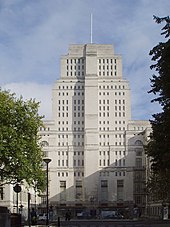
The Bellagio Center operates both a conference center and a residency program.[84] Numerous Nobel laureates, Pulitzer winners, National Book Award recipients, Prince Mahidol Award winners, and MacArthur fellows, as well as several acting and former heads of state and government, have been in residence at Bellagio.[citation needed]
TIMELINE PLUS: Philanthropy and the Rockefeller Legacy
An article from the Philanthropy News Digest
with an excerpted interview with David Rockefeller
Extending Public Health: The Rockefeller Sanitary Commission and Hookworm in the American South https://www.ncbi.nlm.nih.gov/pmc/articles/PMC3910046/

On the Origins of the Population Council
[John D. Rockefeller]
Population and Development Review Vol. 3, No. 4 (Dec., 1977), pp. 493-502 (10 pages)
Published By: Population Council https://doi.org/10.2307/1971690 https://www.jstor.org/stable/1971690
https://en.m.wikipedia.org/wiki/Isotopes_of_iron
Somewhat more indirectly, using philanthropic dollars to bring organization and order into research itself through emphasis on cooperative efforts, creation of research institutions, and the like John D. Rockefeller Sr. and Jr. in 1915 Foundations in particular (as opposed to individual donors) played an extremely important role during the Progressive Era in translating the concerns of the wealthy elites into concrete, scientifically grounded research projects, or into actual social planning. Wesley Clair Mitchell, a Columbia University economist
and an adviser to the Rockefeller Foundation, explicitly related the use of science to achieving social control in a memo to the foundation trustees in 1914:
*Just as science affords the chief means of improving the practice of medicine,
so science affords the chief means of improving the practice of social regu-
lation.“Mitchell to Trustees of the Rockefeller Foundation, Jan. 1914, Rockefeller Foundation Archives, Draft Report 22. A useful study of the ideological and organizational debates
The Rockefeller Foundation Annual Report 1914 https://archive.org/details/the-rockefeller-foundation-annual-report-1914/page/n10/mode/1up
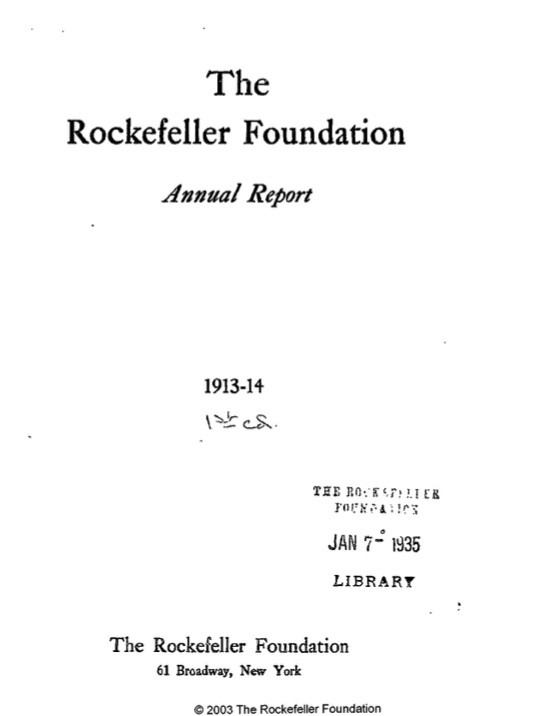


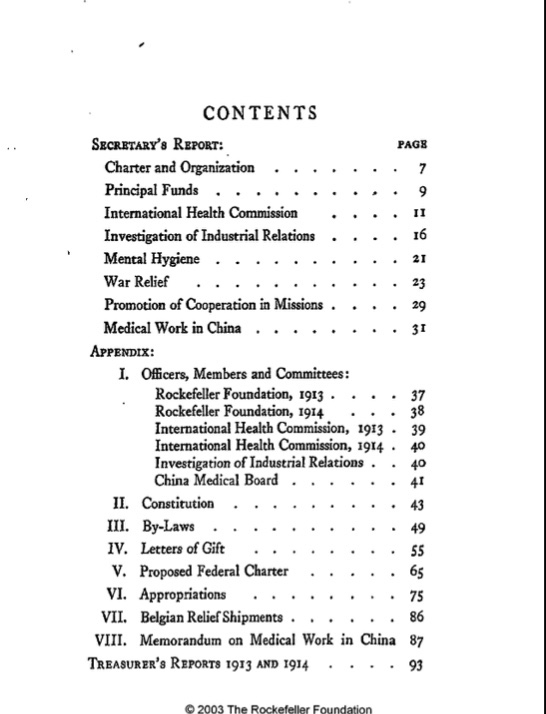

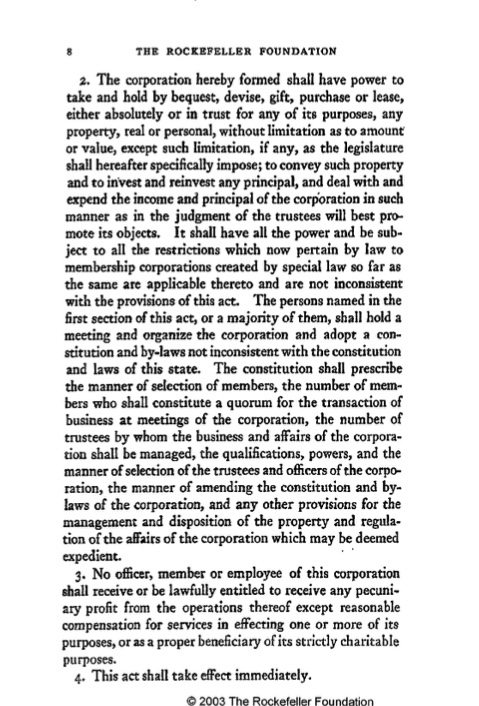
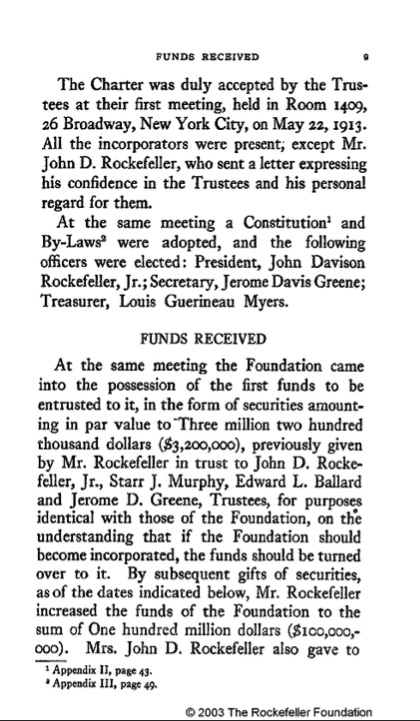
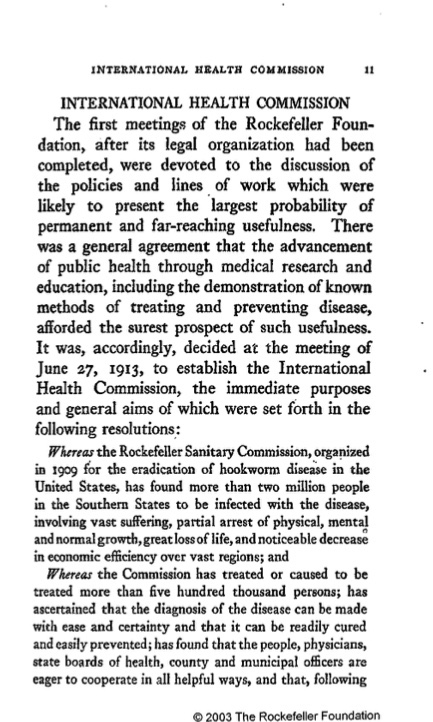

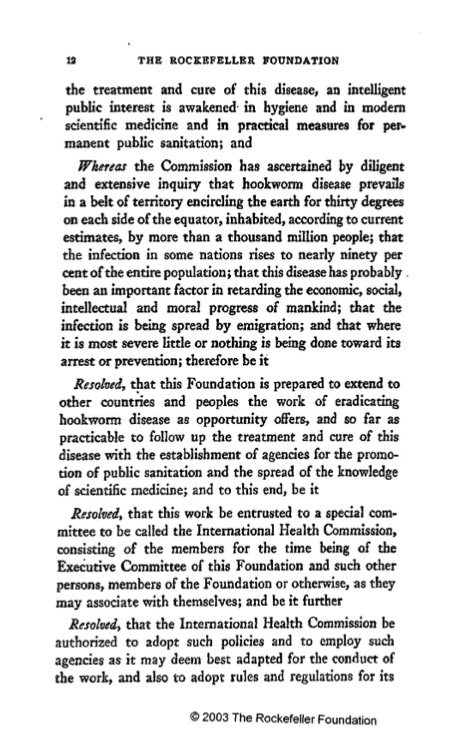
You can read the rest of the report for yourself
https://archive.org/details/the-rockefeller-foundation-annual-report-1914/page/n16/mode/1up

REJECTING MONOPOLY POWER OVER GLOBAL PUBLIC HEALTH
Health regulation – minimize disruptions to essential health services to protect critical public health programs. Means pandemic’s and new medical technology as gene products and bioactive Medicin.
Less freedom more Control! From Health to Harm, from safety to risc access
From Human to Digital ID
Not Healthy not natural but total control by technocrats, banks and steakholder dictatorship!
https://www.sciencedirect.com/science/article/pii/S2667193X21001253
Influencing Public choice
Factors influencing the adoption of self-management solutions: an interpretive synthesis of the literature on stakeholder experiences
https://www.ncbi.nlm.nih.gov/pmc/articles/PMC4644277/
Building back better: A sustainable, resilient recovery after COVID-19
Bill Gates: How we can close the vaccine gap much faster next time
13. Okt. 2021To achieve vaccine equity, we need to do two things: change how the world allocates doses and increase the amount of vaccine doses being produced in… https://edition.cnn.com/2021/10/13/opinions/closing-vaccine-gap-faster-bill-gates/index.html
BILL GATES BANNED VIDEO: „WE’RE INJECTING GENETICALLY MODIFIED ORGANISM’S INTO LITTLE KIDS ARMS“
https://www.bitchute.com/embed/CcsGMlKXgPjk/?feature=oembed#?secret=BaIowL7neP
At the beginning of the video, Bill Gates tells us how they plan to inject our children with Genetically Modified Organisms. At 14:07 in the video, Bill and Melinda Gates seem to gleefully imagine the next, more deadly pandemic and its effect on people’s attitudes towards their solutions.
Why was this video banned from YouTube?
Since the appearance of COVID-19 last year, we have been in a mad rush to develop a vaccine (forgoing typical safety trials) for a virus that turns out to have a 99.7% recovery rate. Why?
The World Health Organization warns that even after being vaccinated we will still need to wear masks. And, by the way, the vaccine may not prevent the further spread of the virus. Ok wait a minute, but we are believed vaccines do so because thats the whole point of a vaccine?
Not anymore now vaccines has changed thair claim and are now by definition for the prevention from death and bad outcomes in hospitalization.
That means that they’re knew from the beginning that Herdimmunity is never possible!
And just 0,01 % of the natural infected people are harmed by the virus.
Data suggests that Risk and illnesses are increased after the vaccine-roleout.
So why Bill Gates and other Stakeholder are so fanatic pushed to vaccinate the world with an experimental vaccine that may not even stop the spread of this virus? A vaccine, that „corporate media“ has told us has recorded 50 times the adverse reactions of the seasonal influenza vaccine. A virus that, „corporate media“ has told us, seems to have mutated twice already. This makes no sense at all!
With the preliminary adverse events being reported, by independent media, the vaccine has turn out to be more dangerous than the virus itself. And why aren’t we told that Bill Gates is a „VACCINE INVESTOR“ and NOT the „corporate media“ narrative that he’s a philanthropist who just loves humanity?
Who is behind this heavily promoted campaign to vaccinate the entire world population? One of the most visible proponents is Bill Gates. Aside from being heavily invested in the vaccine industry and the World Health Organization, (and many other global initiatives that promote vaccines) how exactly is Bill Gates qualified to influence public health policy?
He is not an immunologist or even an elected official, yet for some reason, we look to him when setting public health policies. Bill Gates’s lengthy track record with mass vaccination campaigns in other countries has been disastrous, yet we still take his advice. Why!?
On April 27, 2018, the Business Insider published a widely circulated primer to persuade people to expect a mass killing. The article by Kevin Loria was titled “Bill Gates thinks a coming disease could kill 30 million people within 6 months — and says we should prepare for it as we do for war.”
- The next deadly disease that will cause a global pandemic is coming, Bill Gates said at a discussion of epidemics.
- We’re not ready, Gates said, hiding his family’s and Big Money backers’ plan to loose another most profitable depopulating agent like HIV/AIDS that has killed 40 million people and counting.
- An illness like the pandemic 1918 influenza could kill 30 million people within six months, Gates said, adding that the next disease might not even be a flu, but something we’ve never seen, like a lab combined H5N1 and H1N1 that complicit scientists have already engineered threatening an outbreak that might kill as many as 60 percent of those infected.
- The world should prepare as it does for war, Gates said, hiding the fact that his father was among America’s leading racists and eugenics advocates, and his mother officiated for banks and IBM that made a fortune with the Nazis of WWII.
“If there’s one thing that we know from history, it’s that a deadly new disease will arise and spread around the globe,” Gates was said to herald, according to Loria’s Business Insider advisement.
Gates’s population culling outbreak could happen easily within the next decade, the Business Insider reported.
But who owns the Business Insider? Axel Springer SE. This is the largest digital publishing house in Europe, with numerous multimedia news brands, such as Bild, Die Welt, and Fakt. It generated total revenues of about €3.3 billion in 2015. The enterprise is central to the Deep State’s propaganda output.
This racketeering enterprise wields substantial leverage, and Gates is a major player in this mob. The association is proven by the image below. It shows the Bill & Melinda Gates Foundation vaccine trafficker and founder, Bill Gates, arguably the most murderous man in the world today, congratulating Facebook’s complicit entrepreneur, Mark Zuckerberg, for their alliance.
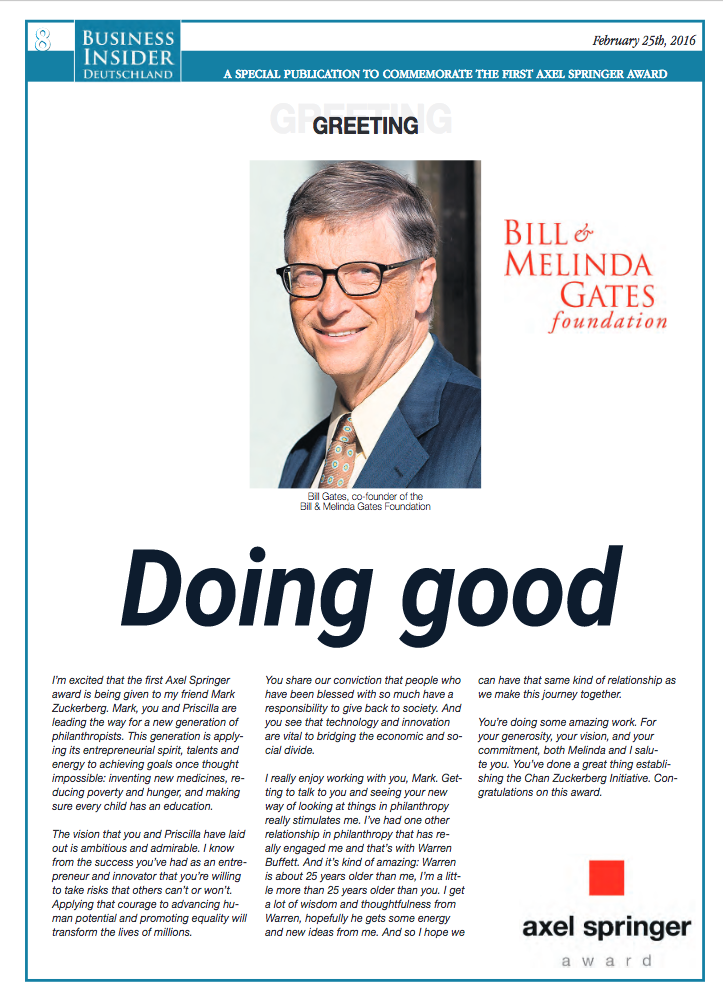
Loria continued for Axel Springer without mentioning that Gates has been heavily financed by Warren Buffett’s $30 billion “donation” to the Gates’s “humanitarian” Foundation.
“Bill Gates told listeners at a discussion about epidemics hosted by the Massachusetts Medical Society and the New England Journal of Medicine.” He claimed, “we’re not ready.” He said he was “usually the optimist in the room.” He reminded people that he lifts children “out of poverty around the globe.”
“But ‘there’s one area though where the world isn’t making much progress,’ Gates said, ‘and that’s pandemic preparedness.’
“The likelihood that such a disease will appear continues to rise. New pathogens emerge all the time as the world population increases and humanity encroaches on wild environments. It’s becoming easier and easier for individual people or small groups to create weaponized diseases that could spread like wildfire around the globe.”
Fraudulent Concealment and Terroristic Threatening
Notice that Gates said nothing about the “small groups” like DARPA and Eco Health Alliance) scientists in labs generating scores of “weaponized diseases.” All of this is ongoing under the guises of “cancer research” and “vaccination prevention.” Gates’s terroristic threatening, all propaganda, persuades We The People to blame our dismal fate on wildlife, air travel, encroachments on rain forests, and lacking “preparedness.” But never on the most obvious threat–massive amounts of biological weapons called “viral recombinants” produced to vaccinate and eradicate people, like animals in risky experiments. Gates’s primary purpose is to divert from GMOs laced with poisonous chemicals and heavy metals–the main ingredients in his genocidal weapons of mass depopulation called “immunizations.”
“According to Gates, a small non-state actor could build an even deadlier form of smallpox in a lab,” Loria wrote.
What total crap! How many “small non-state actors” can build, outfit, and administer a biocontainment level 3 or 4 facility capable of recombinant biotechnology or even crude genetic engineering in microbiology? NONE!

So what is Gates really concealing here? What virologists are actually doing in labs. They are creating deadly biotechnologies for genetic assaults in favor of the financial elite.

Healthcare in 2030:
goodbye hospital, hello home-spital
https://www.weforum.org/agenda/2016/11/healthcare-in-2030-goodbye-hospital-hello-home-spital/
Walker was hired as a senior program officer by the Bill & Melinda Gates Foundation in 2006. Given that the main feature of Walker’s resume at the time was having been a science adviser to another wealthy “philanthropist,” Jeffrey Epstein, her hire by the Gates Foundation for this critical role further underscores how Bill Gates, at the very least, not only knew who Epstein was but knew enough about his scientific interests and investments to want to hire Walker. Walker went on to become deputy director for Global Development as well as a deputy director of Special Initiatives at the foundation. According to the Rockefeller Foundation, where she is a fellow, Walker later advised Gates on issues pertaining to neurotechnology and brain science for Gates’s secretive company bgC3, which Gates originally registered as a think tank under the name Carillon Holdings. According to federal filings, bgC3’s focus areas were “scientific and technological services,” “industrial analysis and research,” and “design and development of computer hardware and software.”
During her time at the Gates Foundation, Walker introduced Boris Nikolic, Gates’s science adviser, to Epstein. Today, Melanie Walker is the cochair of the World Economic Forum’s Global Future Council on Neurotechnology and Brain Science, having previously been named a WEF Young Global Leader. She also advises the World Health Organization, which is closely linked to Bill Gates’s “philanthropy.”
At the WEF, Walker wrote an article in 2016 entitled “Healthcare in 2030: Goodbye Hospital, Hello Home-spital,” in which she discusses how wearable devices, brain-machine interfaces, and injectable/swallowable robotic “medicines” will be the norm by 2030. Years before COVID-19 and the Great Reset–inspired efforts to change health care in just this way, Walker wrote that while the dystopian scenario she was painting “sounds crazy . . . most of these technologies are either almost ready for prime time, or in development.” Of course, a lot of those technologies took shape thanks to the patronage of her former bosses, Jeffrey Epstein and Bill Gates.
In the case of Boris Nikolic, after being introduced to Epstein through Walker, he attended a 2011 meeting with Gates and Epstein where he was photographed alongside James Staley, then a senior JP Morgan executive, and Larry Summers, former Secretary of the Treasury and a close Epstein associate. Nikolic was chief adviser for science and technology to Bill Gates at the time, advising both the Gates Foundation and bgC3. According to the mainstream narrative, this is supposed to be the first time that Gates and Epstein had ever met. In addition, this may have been when Epstein pitched the joint Gates Foundation–JP Morgan “global health charitable fund.”
The 2011 meeting at Jeffrey Epstein’s Manhattan mansion attended by James E. Staley, Larry Summers, Jeffery Epstein, Bill Gates and Boris Nikolic.
In 2014, Nikolic “waxed enthusiastic” about Epstein’s supposed penchant for financial advice ahead of a public offering for a gene-editing company that Nikolic had a $42 million stake in. Notably, both Nikolic and Epstein were clients of the same group of bankers at JP Morgan, with Bloomberg later reporting that Epstein regularly helped those bankers attract wealthy new clients.
In 2016, Nikolic cofounded Biomatics capital, which invests in health-related companies at “the convergence of genomics and digital data” that are “enabling the development of superior therapeutics, diagnostics and delivery models.” Nikolic founded Biomatics with Julie Sunderland, formerly the director of the Gates Foundation’s Strategic Investment Fund.
At least three of the companies backed by Biomatics—Qihan Biotech, eGenesis, and Editas—were cofounded by George Church, a Harvard geneticist with deep ties to Epstein and also closely associated with the Edge Foundation. Biomatics investment in Qihan Biotech is no longer listed on the Biomatics website. Church’s Qihan Biotech seeks to produce human tissues and organs inside pigs for transplantation into humans, while eGenesis seeks to genetically modify pig organs for use in humans. Editas produces CRISPR gene-editing “medicines” and is also backed by the Gates Foundation as well as Google Ventures.
Church has been accused of promoting eugenics as well as unethical human experimentation. Epstein’s significant interest in eugenics was made public after his death, and Bill Gates, as well as his father William H. Gates II, have also been linked to eugenics movements and ideas.
After Epstein’s death in 2019, it was revealed that Nikolic had been named the “successor executor” of Epstein’s estate, further suggesting close ties to Epstein despite Nikolic’s claims to the contrary. After details of Epstein’s will were made public, Nikolic did not sign a form indicating his willingness to be executor and did not ultimately serve in that role.
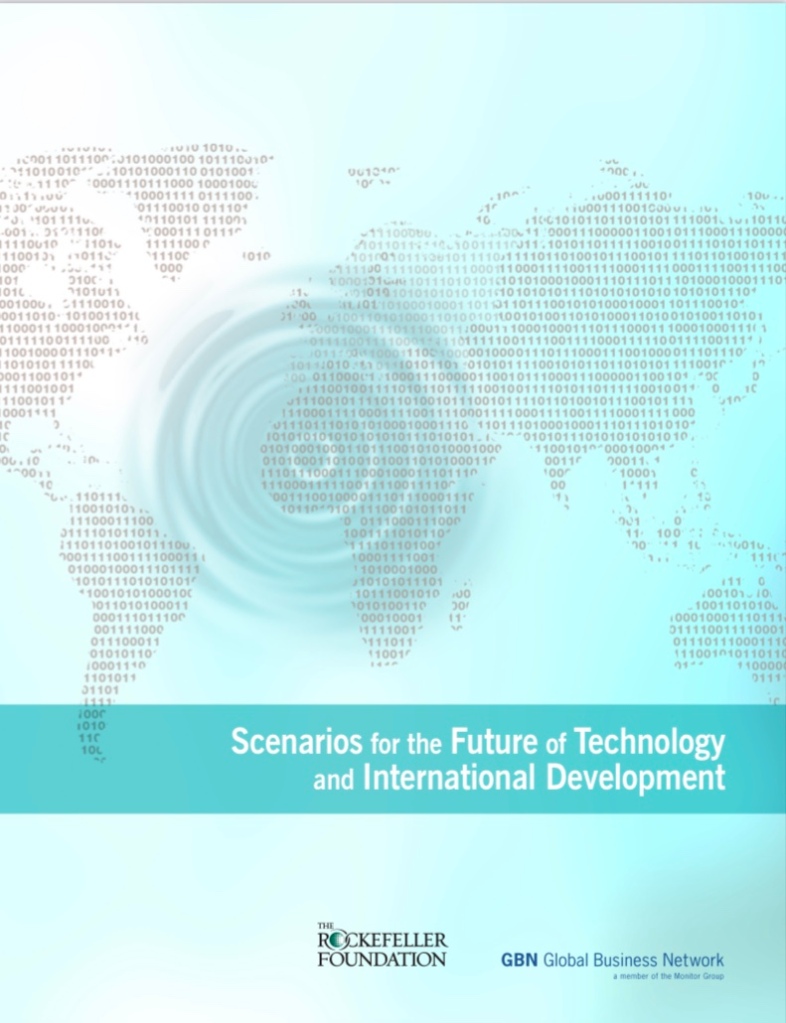
Scenarios for the Future
Download it here
of Technology and
International Development
The 2010 Rockefeller Plan Is Being Methodically Executed:
THE SCENARIO NARRATIVES
The scenarios that follow are not meant to be exhaustive—rather, they are designed to be both plausible and provocative, to engage your imagination while also raising new questions for you about what that future might look and feel like. Each scenario tells a story of how the world, and in particular the developing world, might progress over the next 15 to 20 years, with an emphasis on those elements relating
to the use of different technologies and the interaction of these technologies with the lives of the poor and vulnerable. Accompanying each scenario is a range of elements that aspire to further illuminate life, technology, and philanthropy in that world. These include:
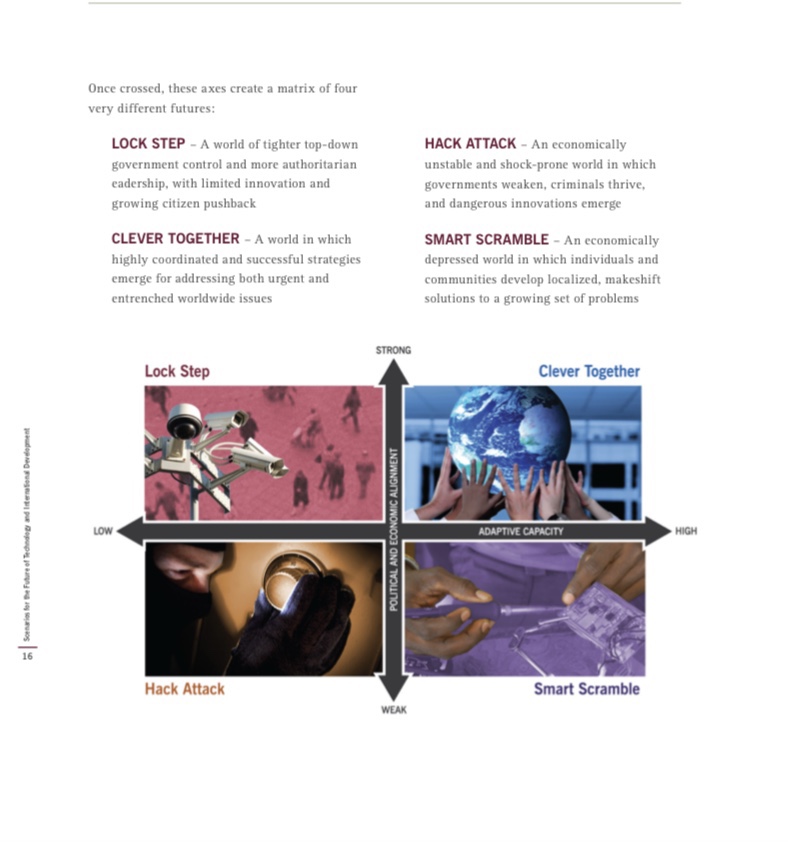
- A timeline of possible headlines and emblematic events unfolding during the period of the scenario
- Short descriptions of what technologies and technology trends we might see
- Initial observations on the changing role of philanthropy in that world, highlighting opportunities and challenges that philanthropic organizations would face and what their operating environment might be like
- A “day in the life” sketch of a person living and working in that world
Please keep in mind that the scenarios in
this report are stories, not forecasts, and
the plausibility of a scenario does not hinge
on the occurrence of any particular detail.
In the scenario titled “Clever Together,” for example, “a consortium of nations, NGOs [non- governmental organizations], and companies establish the Global Technology Assessment Office”—a detail meant to symbolize how a high degree of international coordination and adaptation might lead to the formation of a body that anticipates technology’s potential societal implications. That detail, along with dozens of others in each scenario, is there to give you a more tangible “feel” for the world described in the scenario. Please consider names, dates, and other such specifics in each scenario as proxies for types of events, not as necessary conditions for any particular scenario to unfold.
We now invite you to immerse yourself in each future world and consider four different visions for the evolution of technology and international development to 2030.
LOCK STEP
A world of tighter top-down government control and more authoritarian leadership, with limited innovation and growing citizen pushback
18
In 2012, the pandemic that the world had been anticipating for years finally hit. Unlike 2009’s H1N1, this new influenza strain—originating from wild geese—was extremely virulent and deadly. Even the most pandemic-prepared nations were quickly overwhelmed when the virus streaked around the world, infecting nearly 20 percent of the global population and killing
8 million in just seven months, the majority of them healthy young adults. The pandemic also had a deadly effect on economies: international mobility of both people and goods screeched to a halt, debilitating industries like tourism and breaking global supply chains. Even locally, normally bustling shops and office buildings sat empty for months, devoid of both employees and customers.
The pandemic blanketed the planet—though disproportionate numbers died in Africa, Southeast Asia, and Central America, where
the virus spread like wildfire in the absence
of official containment protocols. But even
in developed countries, containment was a challenge. The United States’s initial policy of “strongly discouraging” citizens from flying proved deadly in its leniency, accelerating the spread of the virus not just within the U.S. but across borders. However, a few countries did fare better—China in particular. The Chinese government’s quick imposition and enforcement of mandatory quarantine for all citizens, as well as its instant and near-hermetic sealing off of all borders, saved millions of lives, stopping
the spread of the virus far earlier than in other countries and enabling a swifter post- pandemic recovery.
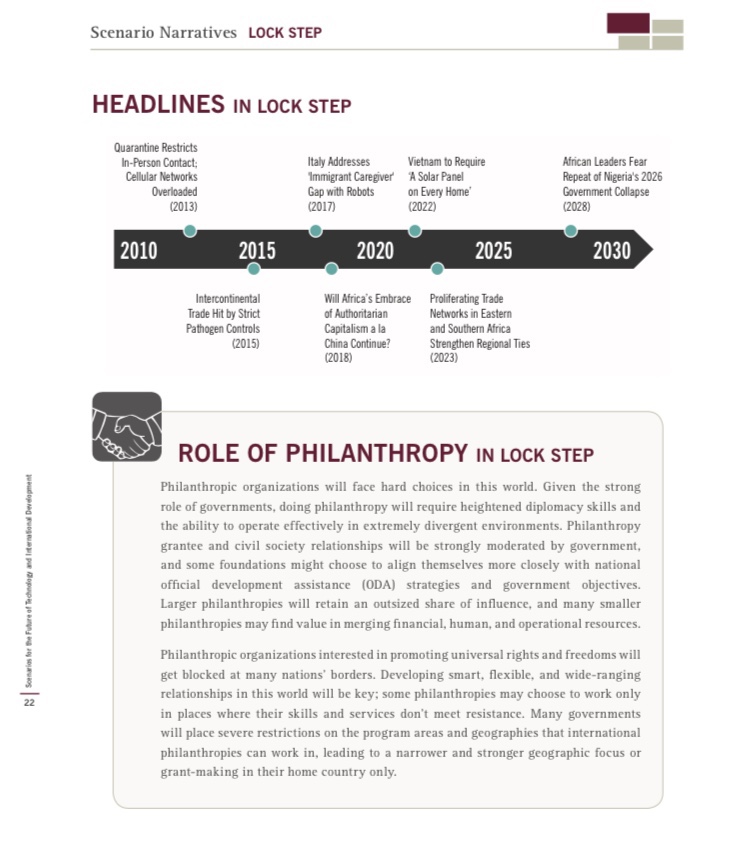
China’s government was not the only one that took extreme measures to protect its citizens from risk and exposure. During the pandemic, national leaders around the world flexed their authority and imposed airtight rules and restrictions, from the mandatory wearing of face masks to body-temperature checks at the entries to communal spaces like train stations and supermarkets. Even after the pandemic faded, this more authoritarian control and oversight
of citizens and their activities stuck and even intensified. In order to protect themselves from the spread of increasingly global problems—from pandemics and transnational terrorism to environmental crises and rising poverty—leaders around the world took a firmer grip on power.
At first, the notion of a more controlled world gained wide acceptance and approval. Citizens willingly gave up some of their sovereignty—and their privacy—to more paternalistic states
in exchange for greater safety and stability. Citizens were more tolerant, and even eager, for top-down direction and oversight, and national leaders had more latitude to impose order in the ways they saw fit. In developed countries, this heightened oversight took many forms: biometric IDs for all citizens, for example, and tighter regulation of key industries whose stability
was deemed vital to national interests. In many developed countries, enforced cooperation with a suite of new regulations and agreements slowly but steadily restored both order and, importantly, economic growth.
Across the developing world, however, the
story was different—and much more variable. Top-down authority took different forms
in different countries, hinging largely on
the capacity, caliber, and intentions of their leaders. In countries with strong and thoughtful leaders, citizens’ overall economic status
and quality of life increased. In India, for example, air quality drastically improved after 2016, when the government outlawed high- emitting vehicles. In Ghana, the introduction
of ambitious government programs to improve basic infrastructure and ensure the availability of clean water for all her people led to a sharp decline in water-borne diseases. But more authoritarian leadership worked less well—and in some cases tragically—in countries run by irresponsible elites who used their increased power to pursue their own interests at the expense of their citizens.
There were other downsides, as the rise of virulent nationalism created new hazards: spectators at the 2018 World Cup, for example,
wore bulletproof vests that sported a patch
of their national flag. Strong technology regulations stifled innovation, kept costs high, and curbed adoption. In the developing world, access to “approved” technologies increased but beyond that remained limited: the locus
of technology innovation was largely in the developed world, leaving many developing countries on the receiving end of technologies that others consider “best” for them. Some
“IT IS POSSIBLE TO DISCIPLINE AND CONTROL SOME SOCIETIES FOR SOME TIME, BUT NOT THE WHOLE WORLD ALL THE TIME.” – GK Bhat, TARU Leading Edge, India
governments found this patronizing and refused to distribute computers and other technologies that they scoffed at as “second hand.” Meanwhile, developing countries with more resources and better capacity began to innovate internally to fill these gaps on their own.
Meanwhile, in the developed world, the presence of so many top-down rules and norms greatly inhibited entrepreneurial activity. Scientists
and innovators were often told by governments what research lines to pursue and were guided mostly toward projects that would make money (e.g., market-driven product development) or were “sure bets” (e.g., fundamental research), leaving more risky or innovative research
areas largely untapped. Well-off countries and monopolistic companies with big research and development budgets still made significant advances, but the IP behind their breakthroughs remained locked behind strict national or corporate protection. Russia and India imposed stringent domestic standards for supervising and certifying encryption-related products and their suppliers—a category that in reality meant all IT innovations. The U.S. and EU struck back with retaliatory national standards, throwing
a wrench in the development and diffusion of technology globally.
Especially in the developing world, acting in one’s national self-interest often meant seeking practical alliances that fit with those interests—whether it was gaining access to needed resources or banding together in order to achieve economic growth. In South America and Africa, regional and sub-regional alliances became more structured. Kenya doubled its trade with southern and eastern Africa, as new partnerships grew within the continent. China’s investment in Africa expanded as the bargain of new jobs and infrastructure in exchange for access to key minerals or food exports proved agreeable to many governments. Cross-border ties proliferated in the form of official security aid. While the deployment of foreign security teams was welcomed in some of the most dire failed states, one-size-fits-all solutions yielded few positive results.
By 2025, people seemed to be growing weary of so much top-down control and letting leaders and authorities make choices for them.
Wherever national interests clashed with individual interests, there was conflict. Sporadic pushback became increasingly organized and coordinated, as disaffected youth and people who had seen their status and opportunities slip away—largely in developing countries—incited civil unrest. In 2026, protestors in Nigeria brought down the government, fed up with the entrenched cronyism and corruption. Even those who liked the greater stability and predictability of this world began to grow uncomfortable and constrained by so many tight rules and by the strictness of national boundaries. The feeling lingered that sooner or later, something would inevitably upset the neat order that the world’s governments had worked so hard to establish.
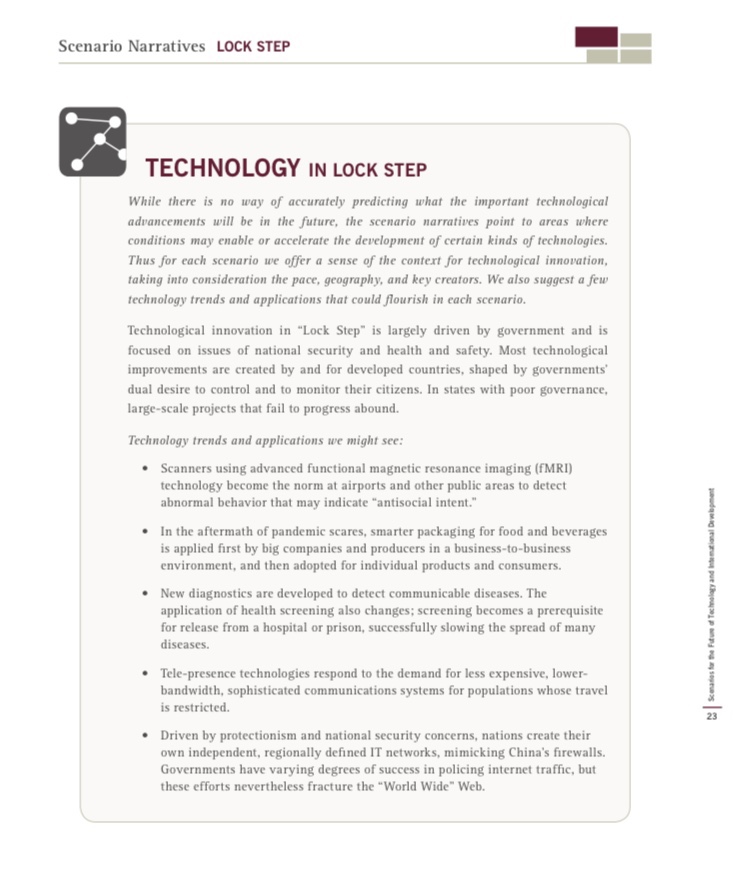

Reliability Engineering & System Safety
Volume 246, June 2024, 110085
Building back better: Modeling decentralized recovery in sociotechnical systems using strategic network dynamics
https://doi.org/10.1016/j.ress.2024.110085Get rights and content
Highlights
- •Bottom-up recovery is crucial for resilience of sociotechnical systems.
- Top-down interventions need to incorporate models of bottom-up processes.
- We propose a multi-agent network framework for modeling Bottom-up recovery.
- Framework includes metrics to evaluate the role of top-down interventions.
Public Health and Medical Professionals for Transparency Documents
If you believe there are improper redactions or withholdings, or if there are records missing, please fill out the form below.
Pfizer 16+ Documents
Documents with a large file size are provided in a .zip file and will need to be uncompressed after download.
As of November 2023, FDA has represented that the production of the biologic product file for Comirnaty (16 years of age and older) is complete. PHMPT is reviewing the production to determine: (1) whether the search FDA conducted appears adequate (in other words, did FDA produce everything expected from the product file concerning safety and efficacy of Comirnaty); and (2) whether there are any potentially improper withholdings or redactions.
DOWNLOAD FULL PRODUCTIONS HERE
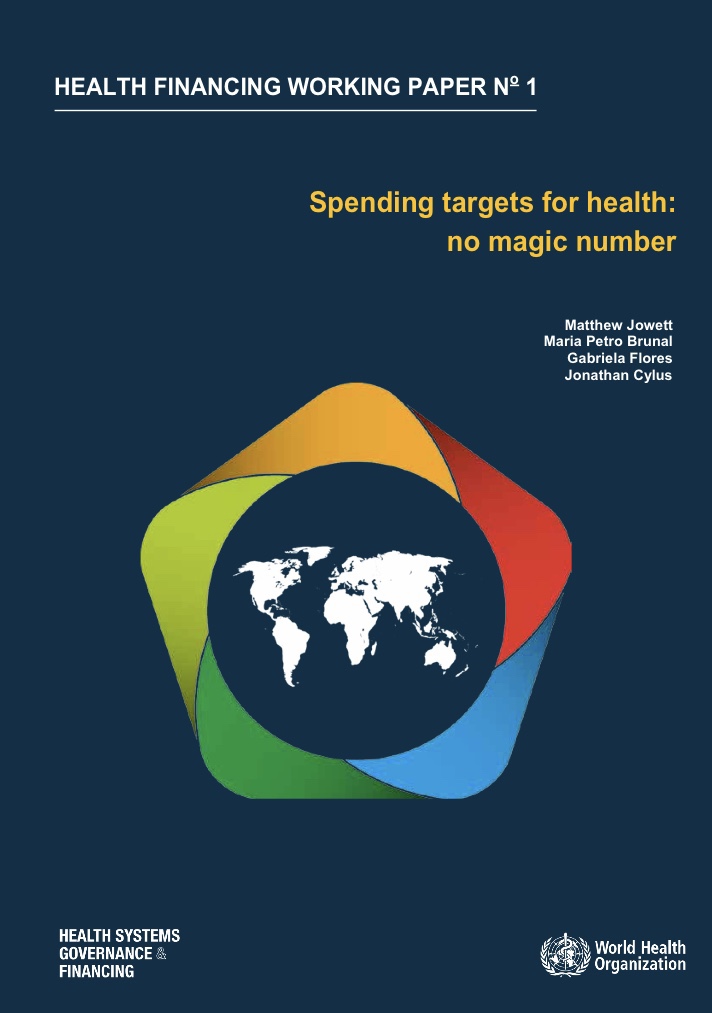
Hinterlasse einen Kommentar